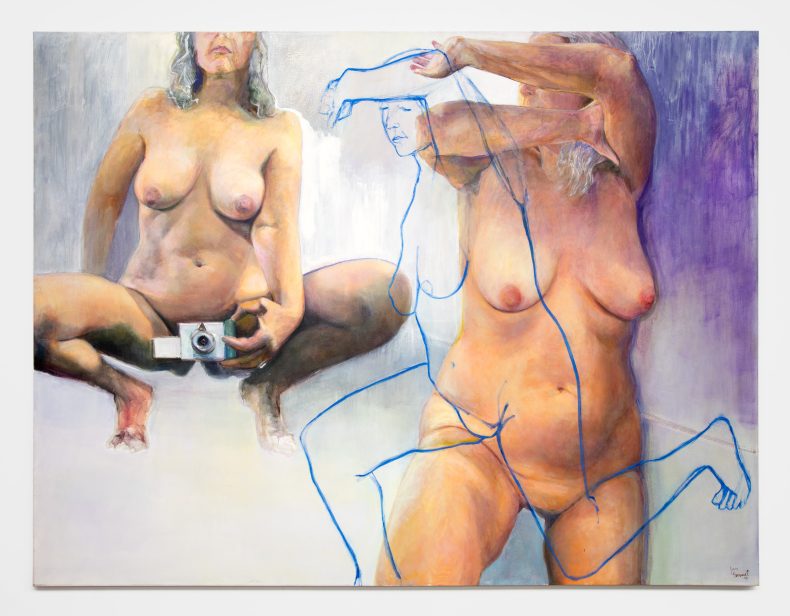Best known today for her nude paintings of women, Joan Semmel began her career as an Abstract Expressionist in the 1950s before leaving the United States for Madrid and moving towards Art Informel. In 1970, after seven and a half years in Spain, Semmel returned to her home town of New York, where the influence of second-wave feminism led her to create sensual – and sometimes explicitly sexual – female-focused figurative canvases. She has based much of her work on her own body, making art that is as personal as it is political. Semmel’s exhibition ‘An Other View’, which spans five decades of her work, is at Xavier Hufkens, Brussels, until 15 June.

Where is your studio?
In SoHo, New York City. It’s a typical SoHo studio, created from warehouses and abandoned factories. I moved here in 1970, after I came back from living in Europe. It was an artists’ neighbourhood – essentially empty except for the artists’ flats and a couple of remaining factories. It was a marvellous environment for making art. The atmosphere was one of community and the lofts were very large.
Back then, the factories would close at 5pm and nobody else was around. The streets were dark and it was illegal to live here. Now it’s a shopping mall, but some of us are still here. My own studio hasn’t changed much since that time.
What is the atmosphere like where you work?
My studio is approximately 2,000 square feet with 14-foot ceilings, which means that you never feel confined. There’s always a sense of air and expansiveness. I have space for my large paintings and racks where I can store work that’s not in use. And when you walk out, you meet your friends because the only people out there are artists.
Does anything frustrate you about your studio?
It would be nice if I didn’t have to walk up a flight of steps to get to it. It’s only one flight, but since the ceilings are so high, that floor is way up. When you’re 91 years old, that’s the most aggravating thing.

How does your New York studio compare to the one you had in Madrid?
My studio in Spain was very different. I lived in a residential area and my apartment had two floors – one for my studio, the other for my family.
In Spain, you weren’t often invited to visit other people’s studios. The life of the artist community there was much more in the street and in cafes. That might have had to do with spaces being more confined, less expansive, than in the kinds of studios you got in New York. But I’m just guessing.
What do you listen to, if anything, while you work?
I usually put on Radio Garden on my computer, so I can tune in to any station easily. I don’t choose anything in particular; I just like some music to fill the space. It sort of blocks out the rest of the world.
Do you have a particular studio routine?
I tend to work every day, regardless of whether or not it’s a weekend. I don’t have a schedule – that’s one of the nice things about being an artist – so if I don’t feel like working, I don’t. But most of the time I do.
A regular day starts with coffee. I need some of that just to get myself going. Then I’ll go to the computer, check my mail and do all that kind of stuff. After that, I’ll head to the studio and start working. Work can mean various things – sorting through my photographs (I work from photographs I take), looking at what I did the day before. There’s a time of just looking and sitting and trying to figure out where I’m going with the work. And then I move into the painting.
Afterwards, it’s whatever anybody would be doing. You meet with friends, you go to galleries, you go to a museum. You live your life.

What is your most well-thumbed book?
I don’t thumb a book, I read it. And I don’t usually go back to it. I do go back and forth looking at paintings, but never with books.
When I first came on the scene, I would read all the feminist literature of the time. I was everywhere and interested in everything. But as you get older you sort of narrow down into your own space and your own idea of what your work is about and who you are.
These days I mostly read newspapers. I am very keyed into a lot of what’s going on in the world; I tend to be more involved in that than in books. At this point I don’t think I respond [to books] in quite the same way as I used to. I did particularly like Tim Snyder’s On Tyranny: Twenty Lessons from the 20th Century (2017), though.
Who is the most interesting visitor you’ve ever had?
I’ve had some interesting collectors come through. Leonardo DiCaprio spent some time here. He was brought by my gallerist and was fun to have around. That was sort of exciting – to pose for pictures with DiCaprio. Of course, he’s used to having young girls to pose with, so this was a little novel for him.
DiCaprio was very interesting. His father was an artist, so we had a lot to talk about.

As told to Arjun Sajip.
‘An Other View’ is at Xavier Hufkens, Brussels, until 15 June.



